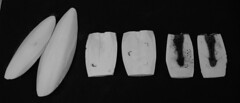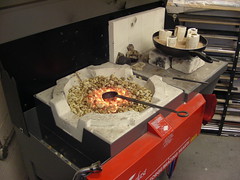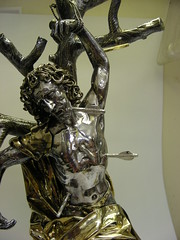By Stuart Frost
 Some objects, like the V&A’s vast tapestry woven with scenes of the Trojan War, have required extensive conservation work to prepare them for display. Conservation of the tapestry, which began in October 2004, was completed recently after approximately 4000 hours of work by specialist conservators. Other objects have required far less time, but the attention to detail has been the same.
Some objects, like the V&A’s vast tapestry woven with scenes of the Trojan War, have required extensive conservation work to prepare them for display. Conservation of the tapestry, which began in October 2004, was completed recently after approximately 4000 hours of work by specialist conservators. Other objects have required far less time, but the attention to detail has been the same.
The reliquary of Saint Sebastian, the focus of this blog entry, is a case in point. This superb example of the art of the metalworker was made in Augsburg in 1497, probably to a design by Hans Holbein. St Sebastian was believed to have been martyred on the orders of the Emperor Diocletian for refusing to renounce his Christian beliefs. Sebastian was tied to a tree and shot with arrows. He miraculously survived the agonising ordeal, only to be clubbed to death subsequently. Sebastian was a popular saint and was represented frequently in medieval and Renaissance art.
The photograph that heads this page depicts the reliquary before conservation treatment. If you look carefully you will see that there are only two silver-gilt arrows still in-situ. However there are holes for a further six and it was recently decided to make replacement arrows for five of these so that when the object is redisplayed visitors will have a better sense of it’s original appearance. Click on the image for a larger picture and a better view.
Metals Conservator Gates Sofer devised an ingenious method for casting the replacement arrows using moulds made from cuttlefish bone. A brass copy of one of the arrows was made and then pressed into cuttlefish bones that had been flattened and paired. This created a mould into which molten metal could be poured. Three stages are shown in the photograph reproduced here, above and to the left. On the left are two cuttlefish bones, in the centre the bones have been flattened and prepared for casting, and finally to the right a mould that has been opened after the casting process. Click on any of the pictures for more information about what is shown. I’ve posted some additional pictures on the Medieval & Renaissance site on Flickr if you’d like to find out a little more about the work.
The casting took place at the V&A. The picture to the right shows a forge in one of the Museum’s workshops, with the ladle used to pour the molten metal to the left, and five cuttlefish moulds standing upright in a pan filled with sand. The cast arrows required additional work once they’d been removed from the mould. The surface of the arrows required working to remove the pattern created by the texture of the cuttlefish bone. In addition the arrows were gilded with eighteen carat gold.
As a general rule conservators like to ensure that any modern additions, like these arrows, can be easily identified and not mistaken for original work. Each of the new arrows bears a tiny V&A logo that was added with a small punch. This mark would be difficult to spot with the naked eye but not a magnifying glass. The addition of the arrows, and the replacement of a missing silver rope used to bind Sebastian to the tree, has subtly transformed the appearance of the object. The reliquary was also carefully cleaned revealing previously obscured details such as a pattern on the border of Sebastian’s garment. 
The reliquary was made by a master craftsmen and is of superb quality. The picture to the left shows the reliquary after the recent conservation work. The object will be looking at its best when it is displayed in Room 10: Devotion & Display. Here St Sebastian will form part of a display about reliquaries. The pedestal of the figure still contains two relics, one is wrapped in silk. The other is thought to be made of wood and was perhaps believed to have been fragments of one of the actual arrow shafts that pierced Sebastian’s body.
I’d like to that Gates for allowing me to use her photographs and for taking the time to talk to me about her work. If you have any questions please post them below and I’ll do my best to answer them.
Thank you very much for the learned post. I would be grateful if you could address the following questions:
Is the figure hollow?
Is possible to identify the number of units from which it is made?
Are there any records of Holbein the Elder’ drawings referring to St Catherine, St Geroge, St Wolfgang and St Boniface which are on the base?
Thank you very much in advance